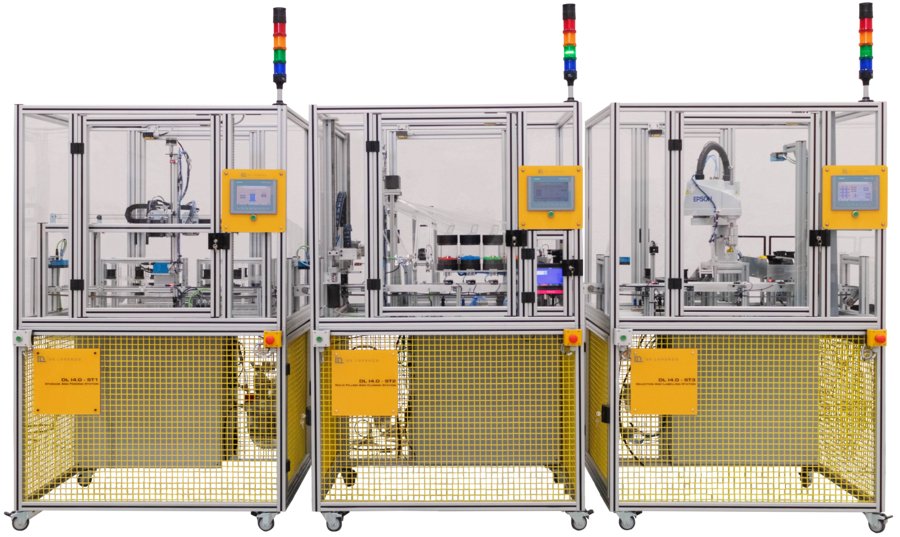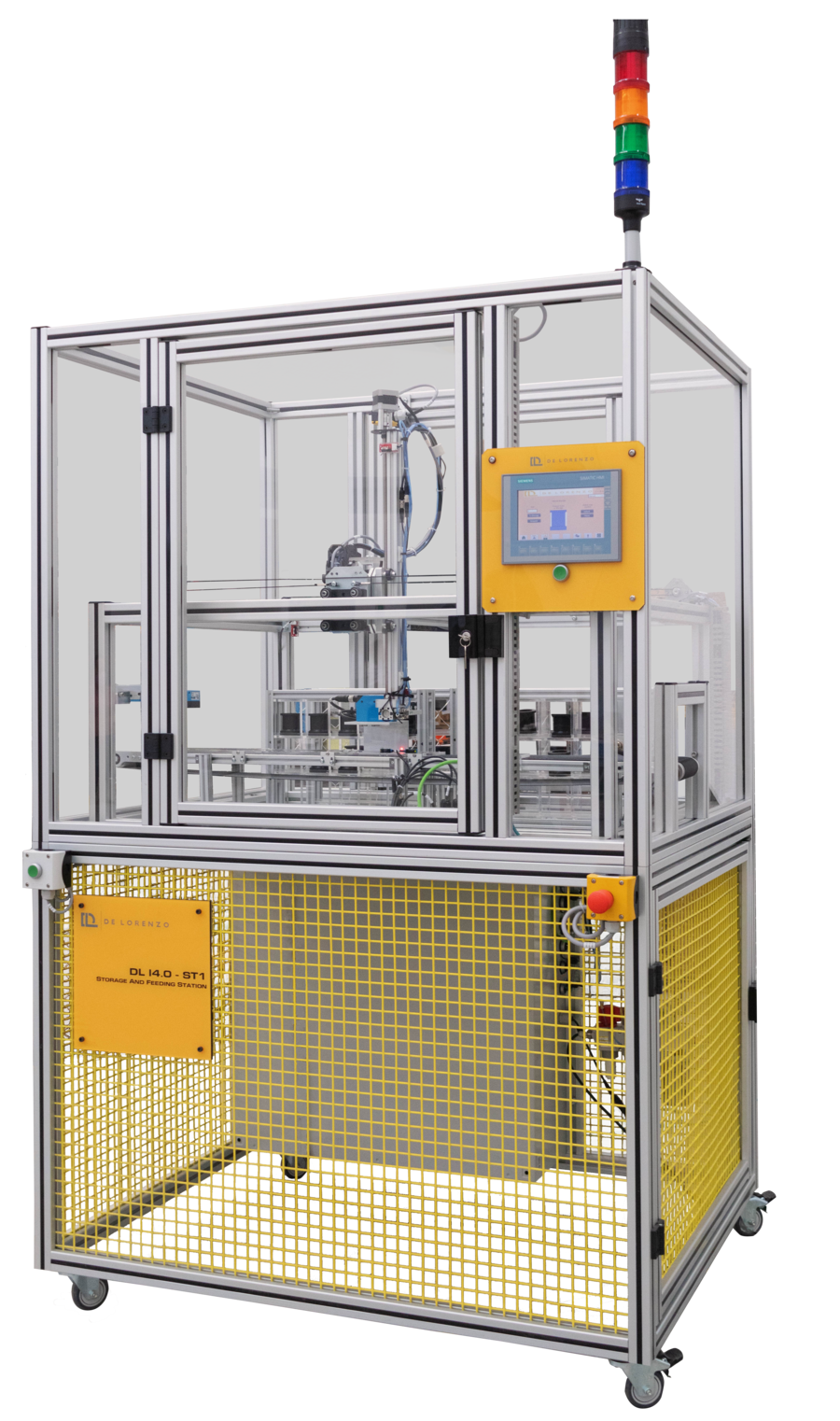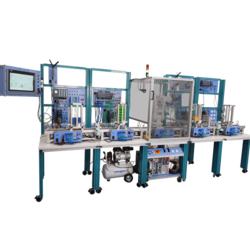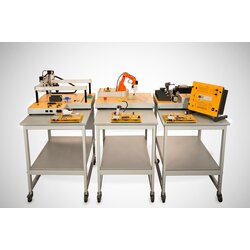Professional Course On Industry 4.0 (DL I4.0)





PL-604232
The DL I4.0 Lab is a collaborative didactic system that integrates hardware processes through software that illustrates the Smart Factory of the future.
Data accumulation using data mining tools allows the student to identify key elements and develop the skills required by the fourth industrial revolution for more efficient planning and more flexible use of resources.
DIDACTICS OF INDUSTRY 4.0
The trainer is designed for technical school, undergraduate and postgraduate students, to learn about the dominant concepts and technologies in the industrial market.
The student will learn how processes, software and hardware relate to each other, to later operate a current “Push” type automated production system and transform it into a “Pull” type system operated in Industry 4.0.
The collaborative platform encourages student participation in multidisciplinary groups to simulate in the classroom conditions and problems typically found in the industry, by developing skills such as teamwork, leadership, and critical thinking, among others.
RELATED COURSES
01 - Mechatronics
02 - Mechanics
03 - Information Technology
04 - Industrial Engineering
05 - Logistics Business
06 - Administration
07 - Business Management
ARCHITECTURE
The DL I4.0 laboratory is made up of 3 main workstations that demonstrate the functioning of a productive Industry: The line achieves the complete operation of a scale factory within a school laboratory, with elements used in the industry, such as: Industrial Hardware, Industrial Software and Simulated Industrial Processes.
The modules interact with each other through different communication protocols, making it an Industry 4.0 Lab. Students will be able to use the platform to carry out career-specific practices, interact with the equipment, take relevant information to specific case studies, and learn new technologies. The limit is the teacher's imagination and what students are allowed to do. 1
PROCESSES.
A key element in any industry that allows a company to operate correctly. For the student, their understanding and assessment is important for a successful professional life. In the trainer, the processes are based on the study of Lean Six Sigma. 2
HARDWARE.
The trainer is composed of 3 stations which together perform the functions of a factory as a whole. In these stations we will find technologies such as: IoLink, PLC, Spray Printer, Barcode Printer, Cartesian Robot, Industrial Scara Robot, Smart Sensors, IoT. 3
SOFTWARE.
Indispensable in the industry and in the life of the student, its use will allow him, in addition to knowing the processes, to obtain specific technical skills in the management of systems such as ERP, Enterprise Resource Planning, WMS, Warehouse Management System, MES, Manufacturing Execution System.
As well as: Software for Data Analysis, Augmented Reality, Virtual Clone. Processes In this laboratory, the student will understand the need to collect all possible information, for later storage and statistical studies for decision-making.
The student will also carry out practices with productive processes that will be perfected through Lean Six Sigma.
OBTAINING DIFFERENT INDUSTRIAL PERFORMANCE INDICATORS (KIPs), SUCH AS:
OEE (Overall Equipment Effectiveness) Purchase Order Costs Deadline Compliance Percentage Average Stock of Raw Materials Supply time Profit or Net Income Productivity Defective Product Stocks Some of the studies allowed by the process section are: Process Capability Indices. - Six Sigma Metrics. Pareto diagrams. - Ishikawa diagrams. Process diagrams. - Quality Function - Deployments (QFD). - Capacity and Stability. Reliability.
FMEA (Failure Mode and Effect Analysis Laboratory based on a LEAN 6 SIGMA industry It is a methodology aimed at improving the products, services, and processes of an organization, incorporating statistical and problem-solving techniques, focused on eliminating defects and reducing possible variations and the process cycle time.
The processes are definable and measurable, and all the generated information can be used to improve them.
The implementation of Six Sigma takes place through five well-defined steps, known as the DMAIC cycle (Define, Measure, Analyze, Improve and Control).
Thus achieving: Reduction of non-quality costs. Defect reduction. Profitability improvement Reduction in complaints.
Lean Manufacturing and Six Sigma By focusing on continuous improvement, we optimize the production system by eliminating waste and activities that add no value to the process.
Thus achieving: A customer- focused system, the generation of significant returns or investments, and the stimulation of a new operational approach.
The system is composed by three collaborative stations
DL I4.0-ST1 Storage and Feeding: This station functions as an Automated Storage and Retrieval System (AS/RS) where the student feeds material into the station through a band and it is then placed by a Cartesian Robot in the locations predefined in the software.
DL I4.0-ST2* Solids Filling and Closing: This station, which communicates with the DL I4.0-ST1 station and the DL I4.0-ST3, is where the P.O. is carried out (Production Order), a Cartesian Robot supplies the containers and labels them to move on to the next station.
DL I4.0-ST3** Selection and Labeling: This station, which communicates with the DL I4.0-ST2 station, is where the part numbers that constitute a P.O. (Purchase Order) are selected and packaged with an industrial SCARA robot.
"ENCOURAGE COLLABORATIVE WORK IN LEARNING AND DEVELOPING STUDENT- CENTERED PROFESSIONAL SKILLS"
All 3 stations are connected through hardware (PLC) and software (SCAP) *Station ST-1 is required for its operation. **Stations ST-1 and ST-2 are required for its operation
CHARACTERISTIC HARDWARE SIEMENS 1500 SERIES PLC IO-LINK MASTER AND SENSORS SCARA ROBOT CARTESIAN ROBOT RFID VISION SENSOR SPRAY PRINTER BARCODE PRINTER Software. Block Diagram
SOFTWARE: Warehouse and Production Control System (SCAP)
WHAT IS IT? An inventory control system is the procedure through which a company efficiently manages the movement and storage of merchandise as well as the resulting flow of information and resources. The didactic objective of our software is for students to identify processes, inventory classification, and reliability (measurement and quantification) in the records that a company manages.
The software performs the functions of warehouse and production management systems, and environmental variables monitoring. The system controls the processes that the stations run, provides Information for decision-making that students will use to develop practices on different subjects.
FEATURES
- Unlimited number of devices or users. Intuitive and natural use.
- No subsequent licensing costs.
- Multiple languages.
- Information backups.
- Monitoring of system inputs.
- Safetyis controlled by the teacher.
- Monitoring of what happens in the station.
- Practice resume function.
- The teacher can restore the information of the practice that was carried out in a previous session.
Background and SCADA programs Interaction with the PLC and the implemented sensors.
- Reading and writing information in the database which is the commanding element in the architecture.
- Execution of web services that interact with the peripheral applications of the cell and where you can develop applications in various programming languages and JAVA.
- They provide the infrastructure required for students to extract information they can use for calculations and considerations that demonstrate their knowledge gained in the classroom.
- They allow augmented reality to exploit information on the elements contained in the cell.
- This layer of software allows Information Technologies career students to carry out practices and applications that interact with the entire laboratory, including sensors and actuators.
- Supervision, Control and Data Acquisition (SCADA) of each of the modules that make up the line. Includes APP's for Android Mobile Devices It allows analysing the processes that are carried out when moving through the warehouse and the “time and motion” involved in its handling.
Warehouse: Implements the basic functions of Cycle Inventory, Warehouse Input, Warehouse Output, Environmental Monitoring and Alerts. Virtual Clone It is an augmented reality environment that displays information through an app developed for Android operating system.
Pointing to markers positioned on the equipment, the application will allow the user to access information from the following two levels:
- Display of administrative and process information.
- Display of technical information.
With this interaction the student will learn how industrial processes work and their impact on hardware performance, allowing information to be generated in the virtual environment without affecting real indicators.
This way, the student will be able to generate a virtual manufacturing, to make decisions on the viability of the production. He will also understand the use of technology implemented in the cells and the functionality of each technological aspect.
Data analysis DATAMINING TOOL The SCAP (Warehouse and Production Control System) software provides mechanisms for extracting information that allow it to be integrated into the “Orange” software in a very simple way, developing the following knowledge:
- Machine Learning
- Data Display
- Interactive Data Analysis
“Systems for the training of professionals in the 4th Industrial Revolution”
PRACTICES INDUSTRIAL ENGINEERING Bar Code Generation Line Balancing VSM Value Stream Mapping Left- hand Right- hand Diagram Human- Machine Diagram Flow chart Process Operations Diagram Route Diagrams OEE Overall Equipment Efficiency Lean Manufacturing Six Sigma
MECHATRONICS ENGINEERING PLC Programming (Siemens Tia Portal) Acquisition of information in analog and digital PLC (Computer Import) Exploitation of IoT (Internet of Things) sensor information Exploitation of IO-Link sensor information Exploitation of RFID information
LOGISTICS ENGINEERING International purchase and sale Import and export flowchart Incoterms Types of transportation (air, land, sea, and river)
INFORMATION TECHNOLOGIES ENGINEERING Database Cloning. Development of entity - relationship diagram. Basic SQL handling. Advanced SQL handling. Stored Procedure Development (Stored Procedure). Triggers development. Web service development.
ENGINEERING IN BUSINESS MANAGEMENT Warehouse generation. Locations generation. Purchase orders from credit suppliers. Production Orders. Management of Suggested Purchases. Development and exploitation of indicators with information from the production line in real time (Mechanical, Mechatronics, Industrial, Business Management and Information Technologies Engineering). Actuator control from IoT sensor information (Mechatronics and Information Technology Engineering). Statistical quality control (Industrial and Information Technology Engineering). Equipment Maintenance (Mechatronics, Information Technology and Industrial Engineering).
What is this?
These percentage scores are an average of 0 user reviews. To get more into detail, see each review and comments as per below
If you have used this product, support the community by submitting your review



